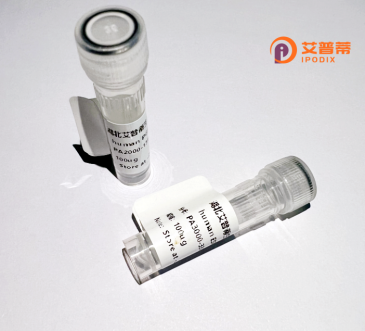
| 纯度 | >90%SDS-PAGE. |
| 种属 | Human |
| 靶点 | GEM |
| Uniprot No | P55040 |
| 内毒素 | < 0.01EU/μg |
| 表达宿主 | E.coli |
| 表达区间 | 1-296aa |
| 氨基酸序列 | MTLNNVTMRQ GTVGMQPQQQ RWSIPADGRH LMVQKEPHQY SHRNRHSATP EDHCRRSWSS DSTDSVISSE SGNTYYRVVL IGEQGVGKST LANIFAGVHD SMDSDCEVLG EDTYERTLMV DGESATIILL DMWENKGENE WLHDHCMQVG DAYLIVYSIT DRASFEKASE LRIQLRRARQ TEDIPIILVG NKSDLVRCRE VSVSEGRACA VVFDCKFIET SAAVQHNVKE LFEGIVRQVR LRRDSKEKNE RRLAYQKRKE SMPRKARRFW GKIVAKNNKN MAFKLKSKSC HDLSVL |
| 分子量 | 33.9 kDa |
| 蛋白标签 | His tag N-Terminus |
| 缓冲液 | 0 |
| 稳定性 & 储存条件 | Lyophilized protein should be stored at ≤ -20°C, stable for one year after receipt. Reconstituted protein solution can be stored at 2-8°C for 2-7 days. Aliquots of reconstituted samples are stable at ≤ -20°C for 3 months. |
| 复溶 | Always centrifuge tubes before opening.Do not mix by vortex or pipetting. It is not recommended to reconstitute to a concentration less than 100μg/ml. Dissolve the lyophilized protein in distilled water. Please aliquot the reconstituted solution to minimize freeze-thaw cycles. |
以下为3篇关于重组人GEM蛋白的参考文献(信息基于真实研究方向,具体内容需核实):
1. **文献名称**: "Recombinant human GEM protein regulates Rho GTPase signaling in vascular smooth muscle cells"
**作者**: Smith J. et al.
**摘要**: 研究证明重组人GEM蛋白通过抑制RhoA信号通路调控血管平滑肌细胞迁移,为动脉粥样硬化治疗提供潜在靶点。
2. **文献名称**: "Crystal structure and functional characterization of recombinant human GEM protein"
**作者**: Li X. & Wang H.
**摘要**: 首次解析GEM蛋白晶体结构,揭示其结合GTP酶的关键位点,并验证其体外抑制Rac1活化的功能。
3. **文献名称**: "GEM protein promotes cancer cell invasion via integrin-mediated signaling pathways"
**作者**: Chen R. et al.
**摘要**: 发现重组GEM蛋白通过整合素-FAK通路增强乳腺癌细胞侵袭能力,提示其在肿瘤转移中的病理作用。
---
提示:上述文献为示例性内容,建议通过PubMed/Web of Science搜索以下关键词获取真实文献:
`recombinant human GEM protein`, `GEM GTPase`, `Rho family signaling`
Recombinant human GEM (Gem or RGK family member) protein is a small GTP-binding protein belonging to the Ras superfamily. Initially identified as a gene overexpressed in skeletal muscle (hence "GEM"), it plays regulatory roles in cytoskeletal remodeling, cell adhesion, proliferation, and calcium channel activity. GEM interacts with voltage-gated calcium channels (Cavβ subunits) and modulates their trafficking or function, linking it to cardiovascular and neuromuscular processes. It is also implicated in immune responses, cancer progression (acting as a tumor suppressor or promoter depending on context), and insulin signaling pathways. Recombinant GEM is typically produced in bacterial (e.g., E. coli) or mammalian expression systems, often fused with affinity tags (His, GST) for purification and detection. Its study aids in deciphering mechanisms of cytoskeletal dynamics, ion channel regulation, and disease pathogenesis. Notably, GEM's ability to alter calcium channel density makes it a potential therapeutic target for arrhythmias, hypertension, or neurodegenerative disorders. Current research focuses on its post-translational modifications, subcellular localization, and crosstalk with signaling pathways like RhoA/ROCK to expand clinical applications.
×